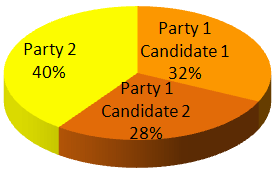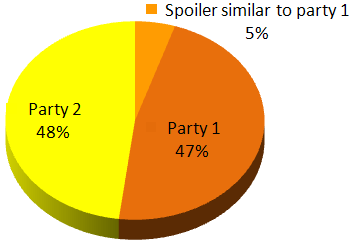|
|
|
|
What are some important fundamental concepts?It has been said the secret to creativity is hiding your sources. I learned long ago that recycling good ideas of others is much easier than developing an original idea. This website is inspired by principles of
How can I discuss anything with someone who has a totally different perspective?
Am I not destroying my enemies when I make friends of
them?
You might start by considering what inspires you to stick with a discussion. How could you help someone else find similar inspiration? What are your goals? What are the other persons goals? If you ask about a goal, and the other person responds with a game-plan, you might ask a follow-up question, such as "why is this important to you?" or "what will happen if you don’t do this?" Hopefully the answer will bring you both closer to understanding the actual goal. If you think you understand the actual goal, you could try rephrasing the response, substituting a possible goal for their game-plan. If someone says, "I wish we could ban all those attack ads!" rather than lecturing them about court decisions or freedom of expression, one possible response is, "It sounds like you’re really frustrated by attack ads and want factual information to help you make an informed choice. Is that correct?" This response recognizes the desire to ban attack ads and transforms the game-plan of banning attack ads into a goal of factual information. Once you both understand each other’s actual goals, is there any common ground? If the common goal is factual information, you can jointly brainstorm and explore several potential game-plans. If there isn’t much common ground, what might inspire you to change your mind? If there is an alternative, would you want to hear it? What might inspire you to seriously consider this alternative? If an alternative might satisfy everyone concerned, would you be willing to shift your own position? What might inspire a change in the other person? If you hear an interpretation, you might ask for a specific observation and consider other possible interpretations of that observation. Why all these questions? Why not just present a specific proposal?An old adage says "Give a man a fish and you feed him for a day. Teach a man to fish and you feed him for life." We could also say, "Give people a solution and you might satisfy them for a day, or perhaps start an argument lasting much longer. Teach people to find their own solutions and satisfy them for life." Accepting a solution provided by someone else might seem comforting, but blindly following may also have unpleasant consequences. Once people become invested in one particular solution, it’s much more difficult for them to see alternatives. If you start by choosing a destination, you can choose from several possible routes, and are free to change routes along the way. If you chose your destination well, you’ll probably like where you are. If not, you’re free to choose another destination. How can I relate to someone who shares nothing in common with me?There may be obvious differences, but two humans likely have much more in common than DNA. When people hate each other more than they want a solution, finding that common humanity is a big step toward resolving differences. It is easier to hate from a distance. Could there be something positive you can both relate to, such as a happy childhood moment, life-changing events, a mentor, role-model, or important life-lessons? Why not just debate a specific proposal?
There are none so blind as those who will not see.
We can easily forgive a child who is afraid of the dark; the real tragedy of life is when men are afraid of the light. Plato Ignorance is bliss. Consider John Godfrey Saxe’s poem "The Blind Men and the Elephant". We could try to settle the blind men’s dispute with a debate followed by a vote. Each blind man could make his case, summoning all the eloquence he can muster and supporting his position with the "facts" of his observations. This approach might produce a "winner", but does it determine once and for all what an elephant really looks like? Should textbooks use this description of elephants? I prefer a system where people clarify shared goals and needs before becoming invested in a particular solution. I benefit by learning from others and by looking for something useful in the positions of others. Taking ideas from various positions may lead to a new option that meets everyone’s goals. If you’re inclined to evaluate one specific proposal at a time, a good place to start is with your own position. What inspires you to reconsider or shift your own position? How well does your current preference meets your own goals and the goals of others who prefer a different option? What if a group can’t find common ground?A group goal doesn’t have to include everything that each member desires. Some members might ask for something at the expense of other members. In these cases, it can help to look deeper at the goals. Do the members seeking these benefits need the cooperation of the entire group or could they achieve this goal on their own? Are there potential benefits for everyone in the group such as an insurance policy or fire department that most will never need, but could be extremely helpful to some? What are the likely consequences of not receiving this benefit? If some members don’t get everything they’d like, is the proposed goal a step in the right direction, creating a foundation for additional changes? Would any members benefit by blocking the goal? If you’re still stuck, take a few minutes to reflect on why you joined the group and what you get out of it. Groups often form to provide benefits to all members; pool efforts, resources and knowledge; and pursue goals that would be difficult for individuals to achieve on their own. Reconnecting with other members may inspire you to shift your position in some way. How does a computer count RCV votes?
Does RCV give some people two or more votes while others only get one vote?Each voting round counts everyone’s vote once. If a voter’s preferred candidate is still in the race, their vote counts along with the next-choice votes from voters whose candidates lost in the previous round. Think about the visualization example. Each time, we count everyone in every line. If there are three rounds of counting, we count everyone three times. Can you point to anyone in any line who didn’t get counted or to anyone who got counted more times than anyone else? Why shouldn’t the one with the most votes win?The one with the most votes will win. Ranked Choice Voting ensures that the "most votes" means over half the votes cast. If there are more than two candidates, it’s likely that each candidate gets less than half the total votes. 
In a non-partisan election, the candidates don’t actually run as members of a party, but still share most of their party’s values. The two candidates in Party 1 have much more in common with each other than with the Party 2 candidate. In the above example the Party 2 candidate wins even though 60% of the voters preferred a Party 1 candidate. What is a "spoiler" candidate?An independent or other-party candidate with little voter support may share many values of another candidate considered "electable" or a "serious-contender". Each vote for this "other" candidate is one less vote for the "electable" candidates and may throw the election to the least-desirable candidate. 
In the above example, the "spoiler" shares much in common with Party 1. If the spoiler wasn’t in the race, most of the spoiler’s supporters would vote for the Party 1 candidate who would then win with over 50% of the vote. As it is, the candidate from Party 2 wins with 48% of the vote. What if there are multiple winners such as a city council or school board?If there are three interest groups, one with 40% of the voters and two groups each with 30% of the voters, an entire city council or school board could be chosen by 40% of the voters. If five candidates are elected by district, each district contains about 20% of the county’s voters. A majority in each district is just over 10% of all voters in the city, county, or district. 11% of the voters could elect a representative objectionable to the other 89%. 
In the recent past, court decisions required that a minority group have some representation on a five-member school board. In the above diagram, the green group is 68% of the population and the yellow group is 32%. How would you draw five districts, each with equal numbers of voters, to fairly represent everyone? How does proportional representation work?If there are two interest groups electing a 5-member city council, and one group includes 60% of the voters and the other group includes 40% of the voters, the majority group elects three of the five council members with the other two council members elected by the minority group. It’s proportional because 60% of the voters elect 60% of the council members. If there are five interest groups of equal size, there is no majority group and each group elects one council member. How do we determine the threshold to win a proportional representation election?One way to think about it is to imagine a tie. For one office, a tie is two candidates each getting exactly half the vote. A candidate with over half the votes breaks the tie and has more votes than all the other candidates put together. If there are more than two candidates and no winner, instant-runoff rounds reduce the number of candidates to two. For five council seats, a tie is six candidates each getting exactly 1/6 of the vote so a winner needs at least one vote more than 1/6 of the total to break the tie. How does the computer count votes for proportional representation?Let’s take the example of one candidate getting 4/6 of the first-choice votes, but only needing 1/6 to win. Although 4/6 of the voters had the same first-choice, they may have different second-choices. The computer calculates a proportion of the extra 3/6 to transfer to each second-choice. If the second-choice votes are evenly split between three other candidates, each of the three second-choice candidates gets an extra 1/6 which is the 3/6 surplus split equally three ways. The extra 1/6 transferred to the three second-choice candidates is enough for those candidates to also win. The 4/6 majority elected four council members as expected, and the total vote count for all four winning candidates together is still 4/6: 1/6 for the first-choice candidate and 3/6 split among the second-choice candidates. If the second-choice votes aren’t an equal three-way split, the computer calculates the actual proportions and continues the process of transferring extra votes and eliminating losing candidates with instant runoff rounds. By the end of the vote count, we have five winners representing the various interests of most voters. |